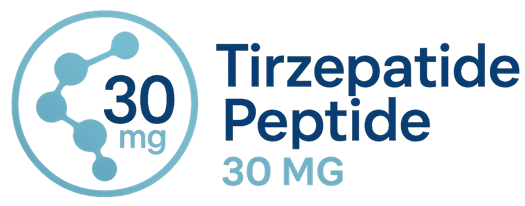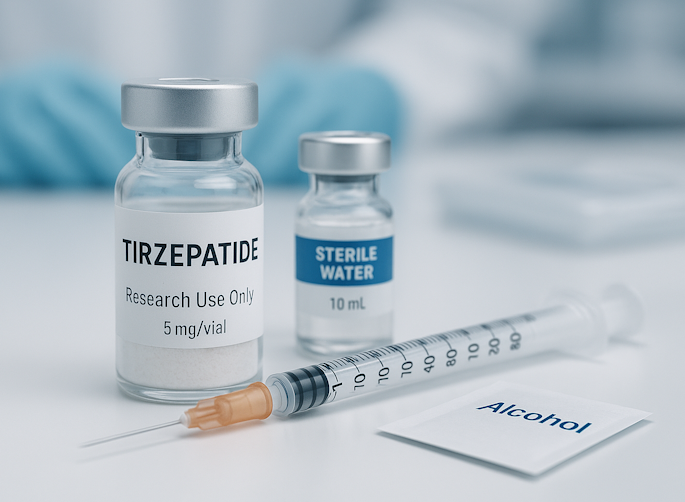Tirzepatide is a novel drug that has become one of the most studied compounds in weight management and diabetes management research. Known for its ability to stimulate GLP-1 and GIP incretin hormones, this peptide helps regulate blood sugar, enhance insulin secretion, and support weight loss in ongoing clinical trials. For researchers working with compounded tirzepatide or lyophilized versions, understanding how to reconstitute it correctly is essential to ensure accuracy, purity, and effectiveness.
This guide provides a detailed, step-by-step guide on reconstitution using sterile technique, proper equipment, and best practices for weight loss, storage, and safety. It is intended for research use only and not for human consumption.
Understanding Tirzepatide Reconstitution
Reconstitution refers to the process of mixing sterile water with lyophilized powder—also known as freeze-dried powder—to form a usable solution for diabetes studies. In its raw form, tirzepatide powder is shipped as a lyophilized powder to preserve its peptide structure and potency. Mixing transforms it into a liquid form that can be stored for short-term research applications.
For context on its powdered state and handling before mixing, read our article on lyophilized tirzepatide.
Because compounded tirzepatide comes in multiple doses multi dose vials, the process must be sterile and consistent. Accurate mixing prevents contamination and ensures the reconstituted version maintains stability throughout its shelf life.
Supplies Needed to Prepare Tirzepatide
- Lyophilized tirzepatide vial: (usually 5 mg, 10 mg, or 15 mg)
- Bacteriostatic water: Sterile water that inhibits bacterial growth and extends the usability of the reconstituted solution
- Syringes: 1 mL or 3 mL insulin syringes with a 29–31 gauge needle
- Alcohol swabs: For disinfecting vial tops and surfaces
- Sterile gloves: To prevent contamination
- Sharps container: For proper disposal of used needles
Following proper injection technique and clean preparation standards helps ensure safety and optimal treatment results in every reconstitution.
Step-by-Step Reconstitution Guide
Step 1: Sanitize and Prepare the Workspace
Before you begin, clean your workspace with alcohol and put on sterile gloves. Wipe the tops of both the tirzepatide vial and the bacteriostatic water vial with alcohol swabs to prevent contamination that could affect blood sugar level. This eliminates the risk of introducing bacteria that could shorten the shelf life of the reconstituted product.
Step 2: Draw Sterile Water
Using a clean syringe, withdraw the recommended amount of bacteriostatic water. The volume depends on the size of the vial and desired concentration. A typical ratio for research is 2 mL of sterile water per 10 mg vial, which creates a 5 mg/mL solution.
Step 3: Add Water to the Tirzepatide Vial
Insert the needle through the stopper and direct the stream of water slowly toward the inner wall of the vial—not directly onto the powder. This gentle technique protects the peptide structure from damage. Avoid shaking the vial; instead, gently swirl until the powder dissolves completely.
Step 4: Let the Solution Settle
Allow the solution to rest for 5–10 minutes at room temperature. The reconstituted tirzepatide should appear clear and free of visible particles. If any cloudiness or clumping remains, discard the vial to ensure purity, safety, and minimize potential side effects.
Step 5: Label and Store Properly
Write the date of reconstitution and calculated concentration on the vial label. Keep the multi dose vials stored in a refrigerator between 36°F and 46°F (proper storage) and away from direct light to maintain the stability of the drug in the body. If you’re unsure about cooling requirements or travel storage, check out why tirzepatide needs to be refrigerated for full storage guidance.
Never freeze reconstituted tirzepatide; freezing can denature the peptide and reduce its effectiveness.
How to Calculate Reconstitution
To determine your solution’s concentration, divide the total milligrams of tirzepatide by the total volume of sterile water added. For example:
- 5 mg + 1 mL water = 5 mg/mL
- 10 mg + 2 mL water = 5 mg/mL
- 15 mg + 3 mL water = 5 mg/mL
These simple ratios help maintain consistent dosing for research use across different vial sizes, ultimately impacting weight management outcome. Always confirm your calculations before drawing doses to ensure accurate distribution and scale of research data.
For dosage conversion references and mg-to-unit breakdowns, review our detailed tirzepatide dosage in units guide.
Drawing the Dose and Injection Technique (For Research Use)
Once the reconstituted tirzepatide is prepared, use a clean insulin syringe to draw the desired dose to inject from the multi dose vial. Ensure that air bubbles are removed and that alcohol swabs are used before any needle contact.
For demonstration in animal or lab-based studies, the subcutaneous injection is typically administered into areas such as the abdomen, thigh, or upper arm. Always follow institutional guidelines for laboratory injection sites and safe disposal of used needles into a sharps container.
Common Mistakes in Reconstitution
- Shaking the vial vigorously instead of gentle swirling
- Using non-sterile or tap water instead of bacteriostatic water
- Failing to refrigerate the reconstituted solution
- Using expired or discolored multi dose vials
- Not properly labeling vials with reconstitution date and concentration
Following sterile instructions and medical supervision where applicable can help ensure safety and consistent treatment outcomes in research studies.
How Long Does Reconstituted Tirzepatide Last?
The shelf life of reconstituted tirzepatide is typically up to 28 days when kept refrigerated. Extreme temperature changes or exposure to light can degrade its potency. To understand degradation timing and how the compound clears, see how long tirzepatide stays in your system.
If left at room temperature for long periods, the solution should be discarded. Never reuse syringes or share multi dose vials between studies, as this increases the risk of bacterial growth or contamination.
Frequently Asked Questions
How do I reconstitute 5 mg of tirzepatide?
To reconstitute a 5 mg vial, draw 1 mL of bacteriostatic water with a sterile syringe and inject it slowly into the vial. Allow the powder to dissolve naturally without shaking. The result is a 5 mg/mL reconstituted solution suitable for laboratory or research use.
How many units is 10 mg?
When 10 mg of tirzepatide is reconstituted with 2 mL of bacteriostatic water, the concentration becomes 5 mg/mL. Using a standard insulin syringe (100 units = 1 mL), each unit equals 0.05 mg of the compound. Therefore, 10 mg equals 200 units in total volume.
How to calculate reconstitution?
To calculate how much to reconstitute, divide the peptide’s total mass by the volume of diluent used. For example, 15 mg divided by 3 mL equals 5 mg/mL. Always check ratios carefully to maintain dosing precision and optimal results for research use.
How many mL is 2.5 mg of tirzepatide?
If the tirzepatide vial is mixed at 5 mg/mL concentration, then 2.5 mg equals 0.5 mL. This helps determine dose volumes for lab measurement, ensuring accurate handling and effectiveness of the reconstituted compound.
Storage and Safety Tips
Always store reconstituted tirzepatide in a refrigerator, between 36°F and 46°F. Avoid freezing it or exposing it to direct sunlight. Label each vial with the prescribed dose or research dosage and reconstitution date.
Discard used needles in a sharps container immediately after use, and clean all surfaces with alcohol swabs. Never reuse or share multi dose vials. If uncertainty exists regarding sterility or stability, consult a healthcare professional or healthcare provider for guidance on safe handling procedures.
Final Thoughts
Learning how to reconstitute properly ensures that compounded tirzepatide maintains its purity, potency, and accuracy during research use. Using clean supplies, precise mixing ratios, and proper storage methods protects the integrity of this novel medication throughout its short shelf life.
From weight loss studies to diabetes research, understanding reconstitution allows scientists to handle the compound safely and effectively. Always follow sterile technique, dispose of materials responsibly, and maintain strict lab protocols to ensure safety and consistency across all studies.
For a complete overview of tirzepatide storage, dosing, and reconstitution practices, visit the Tirzepatide Peptide 30mg homepage.

